Responsive typography is essential for enhancing readability and accessibility across diverse devices and screen sizes. By adjusting text size and layout, it ensures that all users, including those with visual impairments, can engage with content comfortably. Implementing best practices such as using relative units and a mobile-first design approach further optimizes the user experience.
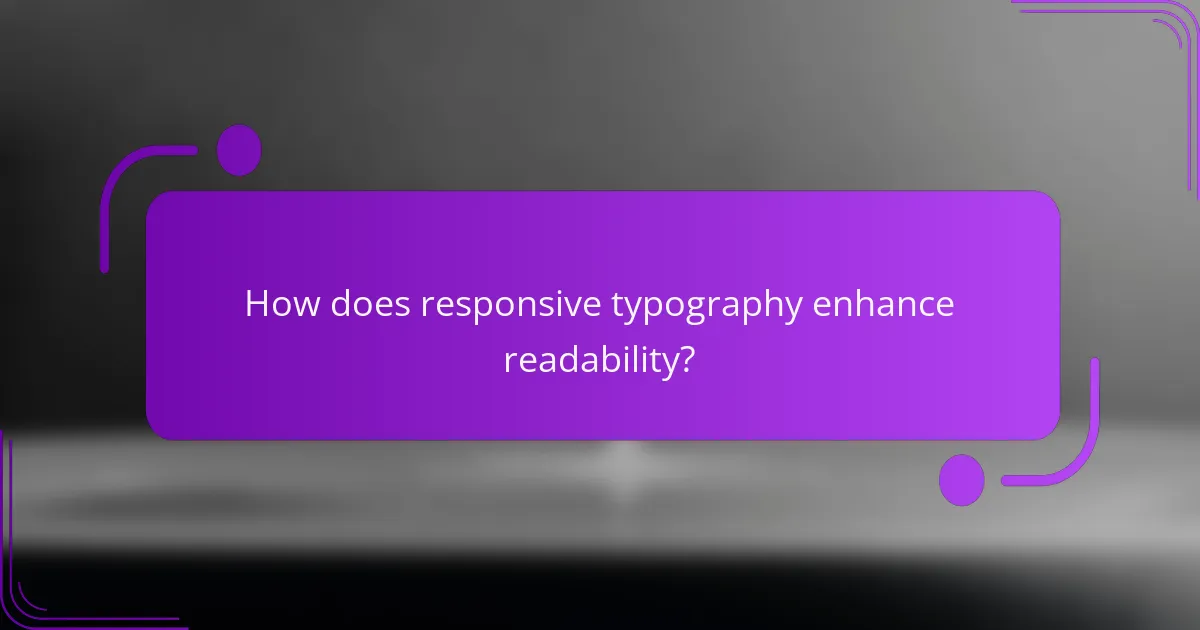
How does responsive typography enhance readability?
Responsive typography improves readability by adjusting text size and layout according to the device and screen size. This adaptability ensures that users can easily read content without straining their eyes, enhancing overall user experience.
Improved text scaling
Text scaling allows fonts to resize based on the viewport, making content more legible on various devices. For instance, a font size of 16px may be appropriate for mobile screens, while larger sizes like 20px or more can be used for desktop displays. This flexibility helps maintain clarity and reduces the need for users to zoom in.
When implementing text scaling, consider using relative units like ’em’ or ‘rem’ instead of fixed units like ‘px’. This approach ensures that text scales proportionally, providing a consistent reading experience across different screen sizes.
Optimal line length
Optimal line length significantly impacts readability, with a recommended range of 50 to 75 characters per line. Lines that are too long or too short can disrupt the reading flow, causing fatigue. By adjusting the width of text containers responsively, you can maintain this ideal line length across devices.
To achieve optimal line length, use CSS properties like ‘max-width’ alongside media queries. This allows you to set specific widths for different screen sizes, ensuring that your text remains easy to read regardless of the device used.
Dynamic font adjustments
Dynamic font adjustments involve changing font styles and weights based on user preferences or device capabilities. For example, using a bold font for headings and a lighter weight for body text can create a visual hierarchy that guides readers through content. This technique enhances comprehension and keeps users engaged.
Consider implementing features that allow users to adjust font sizes or styles according to their preferences. This not only improves accessibility but also caters to a wider audience, including those with visual impairments who may benefit from larger or bolder text.
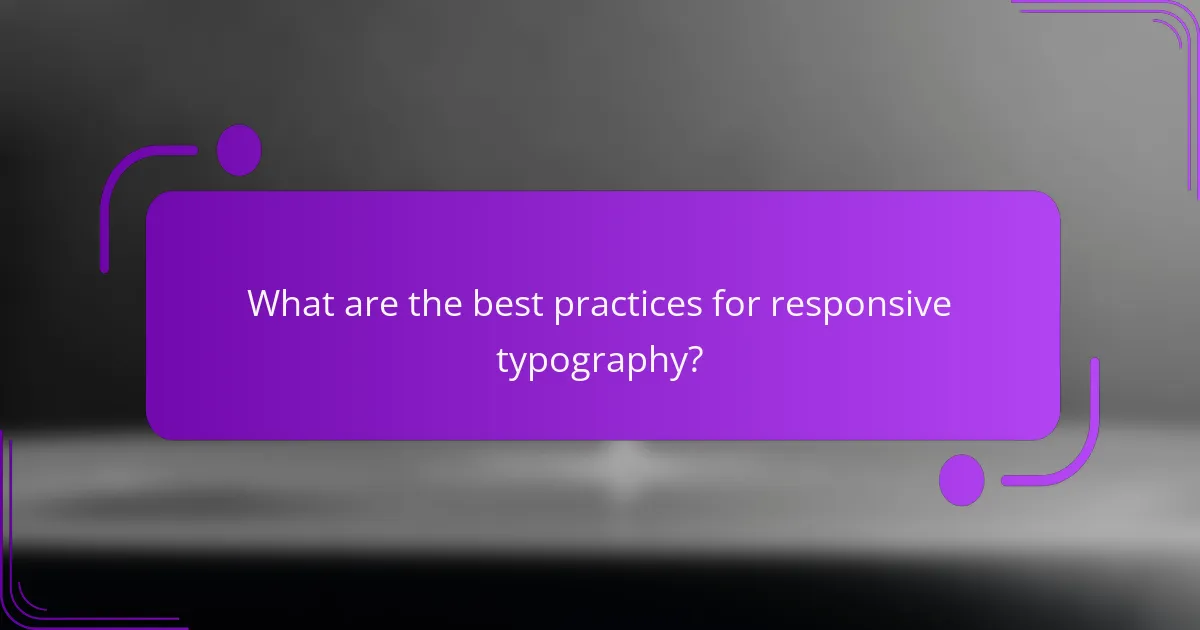
What are the best practices for responsive typography?
Best practices for responsive typography ensure that text is legible and accessible across various devices and screen sizes. Key strategies include using relative units, adopting a mobile-first design approach, and maintaining consistent spacing and margins.
Use of relative units
Using relative units like ems, rems, and percentages allows typography to scale fluidly with different screen sizes. This approach ensures that text remains readable regardless of the device, as it adjusts based on the user’s settings or preferences.
A common practice is to set the base font size in rems, where 1 rem equals the root font size, typically 16 pixels. For instance, a font size of 1.5 rem would be 24 pixels, making it easy to maintain proportional scaling across various elements.
Mobile-first design approach
A mobile-first design approach prioritizes the mobile experience before adapting to larger screens. This method encourages designers to focus on essential content and functionality, ensuring that typography is clear and concise on smaller devices.
Start with a base font size suitable for mobile, then progressively enhance styles for tablets and desktops. This strategy often results in a cleaner, more user-friendly interface, as it avoids unnecessary clutter that can detract from readability.
Consistent spacing and margins
Consistent spacing and margins around text elements enhance readability and create a visually appealing layout. Proper spacing helps prevent text from feeling cramped, which can lead to user frustration and decreased engagement.
As a guideline, aim for line heights of 1.5 to 1.6 times the font size and maintain margins that allow for comfortable reading. For example, if the font size is 16 pixels, a line height of 24 to 26 pixels can significantly improve text clarity on all devices.

How does responsive typography impact accessibility?
Responsive typography significantly enhances accessibility by ensuring that text is legible across various devices and screen sizes. This adaptability allows users with visual impairments or reading difficulties to engage with content more effectively, improving their overall experience.
Support for screen readers
Responsive typography can improve compatibility with screen readers, which convert text to speech for visually impaired users. Using semantic HTML elements and ensuring proper text scaling helps screen readers interpret content accurately. Avoiding overly complex layouts also aids in clearer navigation for these tools.
Contrast and color considerations
High contrast between text and background is crucial for readability, especially for users with color blindness or low vision. Aim for a contrast ratio of at least 4.5:1 for normal text and 3:1 for large text. Tools like the WebAIM Contrast Checker can help assess whether your color choices meet accessibility standards.
Adjustable text sizes
Allowing users to adjust text sizes enhances accessibility for those with visual impairments. Implement relative units like ems or percentages instead of fixed pixels, enabling users to scale text without breaking the layout. A common practice is to ensure that text remains readable at sizes ranging from 16px to 24px for body text.
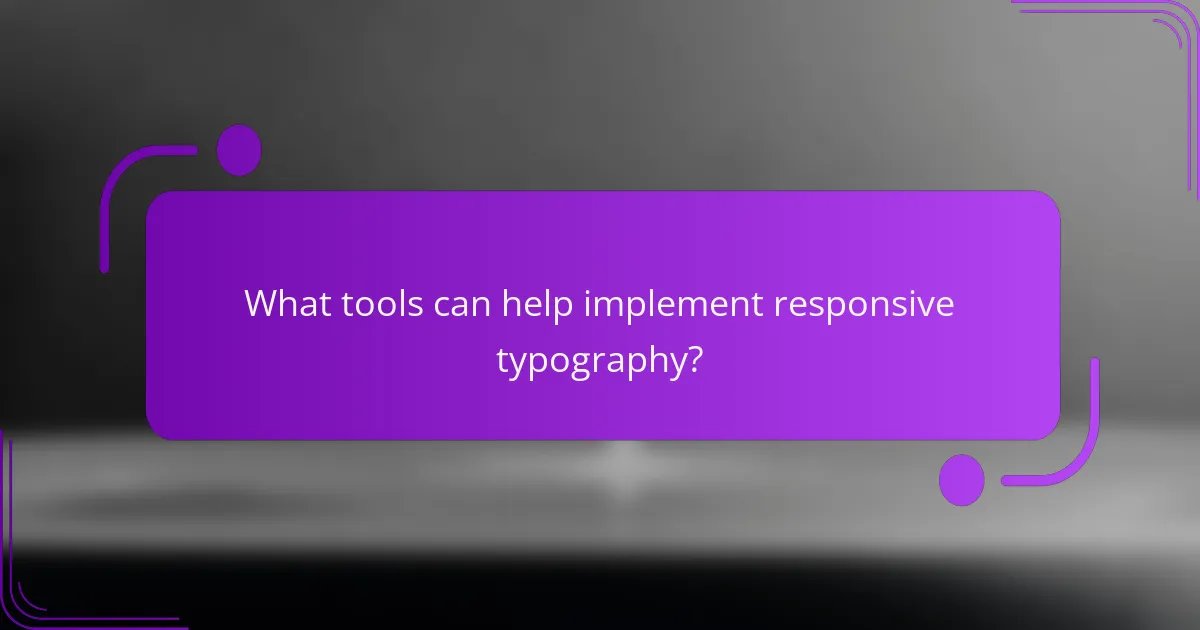
What tools can help implement responsive typography?
Several tools can assist in implementing responsive typography, enhancing readability and user experience. These tools provide various font options, customization features, and frameworks that simplify the process of adapting text to different screen sizes.
Google Fonts
Google Fonts offers a vast library of free, open-source fonts that are easy to integrate into web projects. Users can select fonts based on categories, popularity, or specific styles, ensuring that typography aligns with the overall design. The platform also provides a simple API for embedding fonts directly into websites.
When using Google Fonts, consider the loading time and performance. Limit the number of font families and weights to optimize page speed. A good practice is to choose no more than two or three font families to maintain visual coherence.
Adobe Typekit
Adobe Typekit, now part of Adobe Fonts, provides a premium selection of high-quality fonts that can be used across various platforms. It allows users to sync fonts for offline use and offers extensive customization options for web typography. This service is particularly beneficial for designers seeking unique typefaces that enhance brand identity.
To effectively use Adobe Typekit, ensure you have an appropriate subscription plan that fits your needs. Also, consider the licensing agreements for commercial use, as some fonts may have restrictions that affect your project.
Bootstrap typography utilities
Bootstrap includes built-in typography utilities that make it easier to create responsive text layouts. These utilities allow for quick adjustments to font sizes, weights, and line heights, ensuring that text remains legible on various devices. Bootstrap’s grid system also supports responsive typography by allowing text to scale with the layout.
When using Bootstrap, leverage its responsive classes to adjust typography based on screen size. For example, use classes like .display-1 to .display-6 for headings that automatically adjust size for different devices. This approach helps maintain readability without extensive custom CSS.
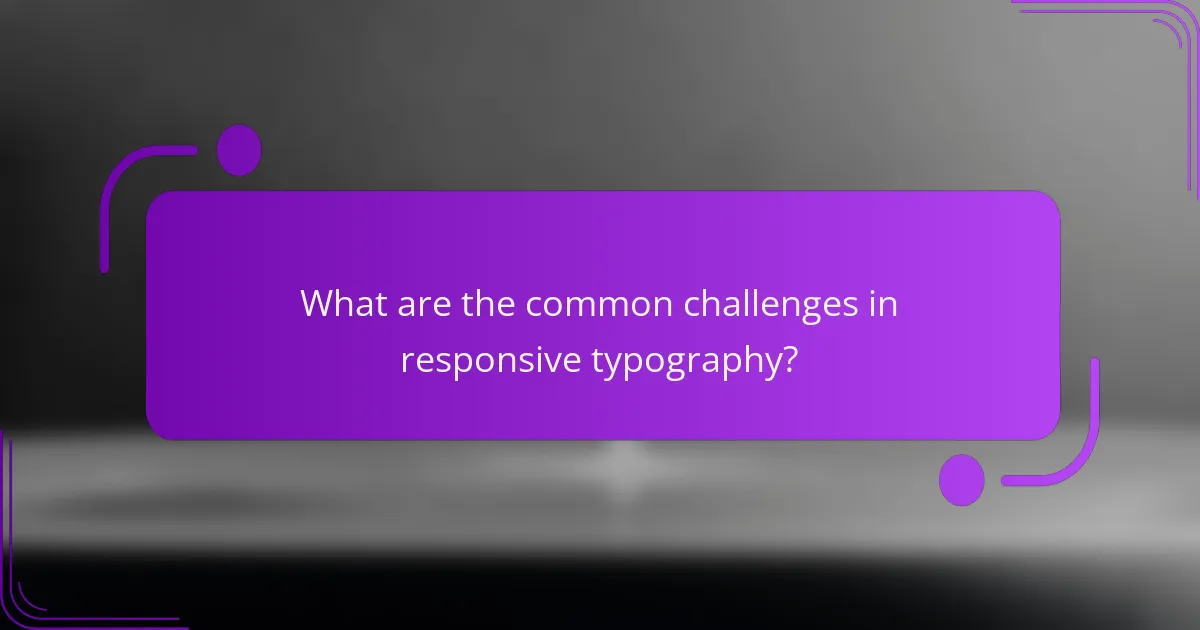
What are the common challenges in responsive typography?
Responsive typography faces several challenges that can impact readability and user experience. Key issues include browser compatibility, performance impacts, and maintaining design consistency across various devices.
Browser compatibility issues
Different browsers may render fonts and text sizes inconsistently, leading to a fragmented user experience. For instance, CSS properties like ‘rem’ and ’em’ can behave differently across browsers, affecting how text scales on different devices.
To mitigate these issues, always test typography across major browsers such as Chrome, Firefox, Safari, and Edge. Utilizing CSS resets or normalizers can help create a more uniform appearance.
Performance impacts
Responsive typography can affect page load times, especially when using web fonts. Loading multiple font weights or styles can increase the number of HTTP requests, which may slow down performance.
To enhance performance, limit the number of font weights and styles used. Consider using system fonts or font-display strategies like ‘swap’ to improve loading times without sacrificing user experience.
Design consistency across devices
Ensuring design consistency in typography across various devices can be challenging due to different screen sizes and resolutions. Text that looks good on a desktop may appear cramped or oversized on mobile devices.
Use relative units like percentages or viewport units for font sizes to maintain proportionality. Implementing media queries can also help adjust typography settings based on device characteristics, ensuring a cohesive look and feel.
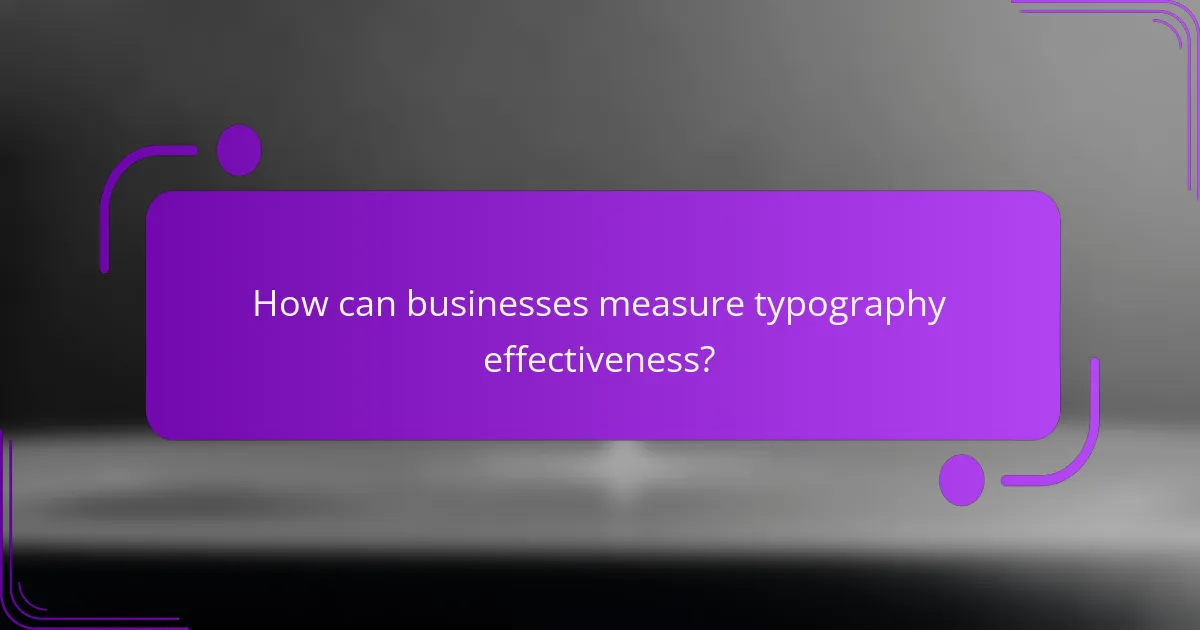
How can businesses measure typography effectiveness?
Businesses can measure typography effectiveness by gathering user feedback and analyzing engagement metrics. These methods provide insights into how typography impacts readability and overall user experience, allowing for informed adjustments.
User feedback and surveys
User feedback is a direct way to assess typography effectiveness. Conducting surveys can help identify how users perceive text legibility, font size, and overall readability. Questions might include preferences for font styles or sizes, and whether users find the text easy to read on various devices.
Consider using tools like Google Forms or Typeform to create simple surveys. Aim for a diverse audience to gather a range of opinions, ensuring that feedback reflects different user needs and preferences.
Analytics on engagement metrics
Engagement metrics provide quantitative data on how typography affects user interaction. Key metrics include time spent on page, bounce rates, and scroll depth. For instance, if users spend more time on pages with larger, clearer fonts, this may indicate that typography is enhancing readability.
Utilize analytics tools like Google Analytics to track these metrics. Set benchmarks for comparison, such as measuring changes before and after typography adjustments. This data can guide further refinements to improve user experience.
